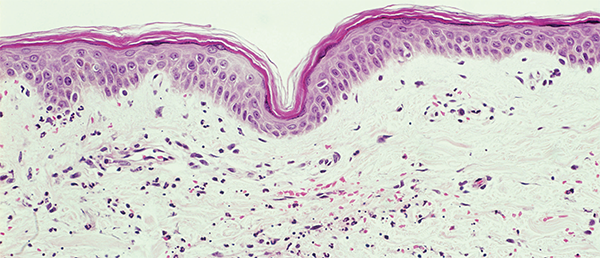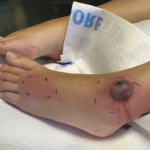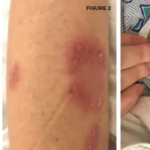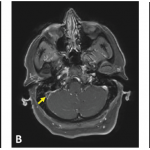Dr. Jorizzo said he is struck by how often Behçet’s disease is overdiagnosed. The problem, he said, is that many people have canker sores, many have genital herpes and nearly everyone has acne. If you add in an issue with the eye, nearly all of the criteria for this diagnosis are then met, he said.
In 2005, Dr. Jorizzo documented how out of 81 patients referred to his clinic with Behçet’s, only 10 of them actually had the disease.2 Fifty-four of them had complex aphthosis, another disorder which is characterized by ulcers, but is much less serious.
‘I like to include the word vascular, because I believe the neutrophilic process is vessel based, primarily, & that distinguishes this from diseases where the epidermis is the target, such as psoriasis.’ —Dr. Jorizzo
Bowel-Associated Dermatosis-Arthritis Syndrome
Speaking about bowel-associated dermatosis-arthritis syndrome, Dr. Jorizzo described it as a condition similar to a syndrome that used to be seen in patients who’d had bowel bypass surgery. Even after that procedure was discontinued, there were still patients with erythematous and purpuric papules and vesicles and nodular panniculitis, with associated polyarthritis and tenosynovitis.
Findings on histopathology include dermal nodular perivascular neutrophilic infiltrate with edema and lobular neutrophilic and septal panniculitis. Dr. Jorizzo said he described this condition many years ago in a previous study.3
He said that inflammatory bowel diseases are important causes and emphasized management of the underlying disease.

Small vessel neutrophilic vasculitis.
Biophoto Associates/ScienceSource.com
Pyoderma Gangrenosum
On the topic of pyoderma gangrenosum, Dr. Jorizzo said this condition can appear with ulcers, be bullous, involve pustules or appear in a superficial granulomatous form. The most characteristic lesion, Dr. Jorizzo said, is an ulcer with a necrotic undermined border and a base that can be purulent or vegetative.
Most patients with pyoderma gangrenosum have large ulcers, he said, but no inflammation. One way to tell that there is no inflammation—and that the patient only needs wound healing—is the “Gulliver’s sign,” rope-like strands of epithelium crossing from the skin to the bed of the ulcer, he added.
He said this is a diagnosis of exclusion and that it’s important to look for mimics, including granulomatosis with polyangiitis histoplasmosis. He said he’s even been surprised by the how frequently he sees factitial disease, in which people harm their own skin.
“You would be amazed,” Dr. Jorizzo said, “at what people do to legitimize a psychiatric problem with a medical one.”
Thomas R. Collins is a freelance writer living in South Florida.
References
- Jorizzo JL, Solomon AR, Zanolli MD, et al. Neutrophilic vascular reactions. J Am Acad Dermatol. 1988 Dec;19(6):983–1005.
- Letsinger JA, McCarty MA, Jorizzo JL. Complex aphthosis: A large case series with evaluation algorithm and therapeutic ladder from topicals to thalidomide. J Am Acad Dermatol. 2005 Mar;52(3 Pt 1):500–508.
- Jorizzo JL, Apisarnthanarax P, Subrt P, et al. Bowel-bypass syndrome without bowel bypass. Bowel-associated dermatosis-arthritis syndrome. Arch Intern Med. 1983 Mar;143(3):457–461.


